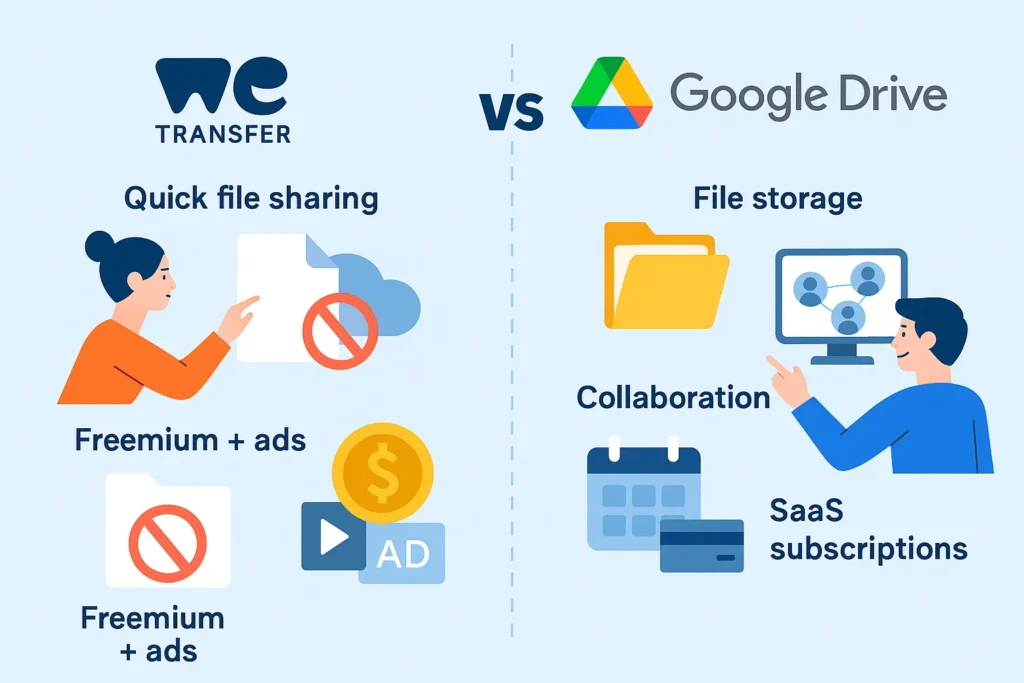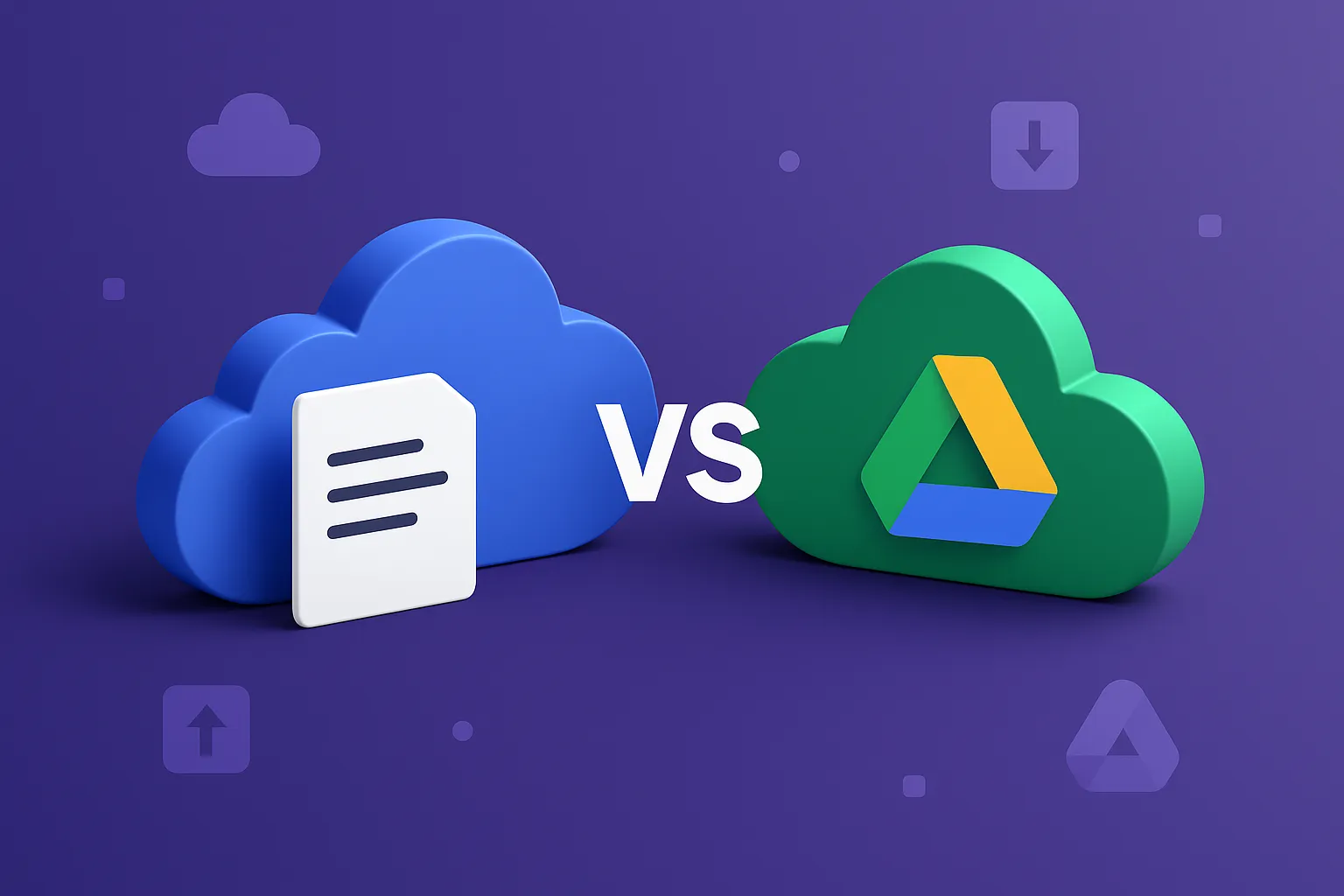In 2025, the demand for secure, seamless, and scalable file sharing and storage solutions has grown exponentially. From remote teams to global creative agencies, data movement is the lifeline of modern productivity. Two of the most recognized platforms dominating this space are WeTransfer and Google Drive.
While both platforms serve overlapping needs—file sharing and storage—they cater to different user behaviors and operate under distinct business models. Whether you’re a SaaS startup founder, a cloud-based app builder, or someone exploring the next-gen file transfer platform, understanding the differences between WeTransfer and Google Drive can help define your product strategy, pricing model, and user experience.
This blog dissects the business models of both platforms in a structured and EEAT-compliant way to help you choose the right path—or blend both for a powerful hybrid solution.

What is WeTransfer?
WeTransfer is a file-sharing service that allows users to send large files (up to 2GB for free, and up to 200GB for paid users) easily and quickly—without the need for registration or cloud storage accounts. WeTransfer is best known for its minimal UI, speed, and creativity-focused branding.
Key Highlights:
- Founded in 2009 in the Netherlands
- Target audience: designers, marketers, agencies, and freelancers
- Known for one-time transfers, not cloud storage
- Offers creative tools like Paste (presentation), Collect (content saving), and Paper (sketching)
What is Google Drive?
Google Drive is a cloud-based file storage and collaboration platform from Google. Integrated into the broader Google Workspace suite, GoogleDrive allows users to store, share, edit, and collaborate on documents in real-time.
Key Highlights:
- Launched in 2012 by Google
- Offers 15GB free storage (shared across Gmail, Photos, etc.)
- Integrates with Docs, Sheets, Slides, Meet, and more
- Designed for both individual and enterprise use
Business Model of WeTransfer
WeTransfer’s business model is built around freemium + creative tools monetization. It attracts users with its free, frictionless sharing and then monetizes through premium services and creative products.
Revenue Streams:
- WeTransfer Pro & Premium Plans: Subscription-based model with higher limits and customization
- Creative Suite Tools: Paste, Collect, and Paper (premium access)
- Advertising: Visually rich background ads on free transfer pages
- WePresent: Branded content + sponsored editorials
Cost Structure:
- File transfer bandwidth and server infrastructure
- Development of creative tools and SaaS updates
- Customer support and user experience R&D
- Global marketing and content production
- GDPR compliance and secure file delivery
Key Partners:
- Cloud infrastructure providers (e.g., AWS)
- Creative brands & agencies for WePresent partnerships
- Payment processors (Stripe, etc.)
- Integration partners (Adobe, Apple Notes, etc.)
Growth Strategy:
- Expand user base in creative industries and remote-first teams
- Integrate deeper with third-party productivity tools
- Bundle creative tools into Pro offerings
- Increase branded storytelling and visual advertising
Learn More: Top Google Drive Features Every Startup Needs
Business Model of Google Drive
Google Drive operates under Google’s broader freemium + enterprise SaaS model. It’s part of Google Workspace, which monetizes through individual and organizational subscriptions.
Revenue Streams:
- Google One Subscriptions: Storage upgrades for individuals
- Google Workspace Plans: Monthly enterprise SaaS for teams
- App Ecosystem: Integration with third-party SaaS tools
- Cross-sell into Google Cloud & Ads ecosystems
Cost Structure:
- Data center infrastructure and scalability (Google Cloud)
- Software engineering for ecosystem maintenance
- Support, security, and compliance infrastructure
- Marketing for Workspace and enterprise onboarding
- AI integrations (search, Drive Suggestions, etc.)
Key Partners:
- Enterprises and schools using Google Workspace
- Third-party app developers (e.g., Slack, Zoom integrations)
- Cloud service resellers and IT partners
- Google Ads for upselling Google One
Growth Strategy:
- Leverage AI to automate storage management and productivity
- Expand Workspace adoption among SMBs and global enterprises
- Enhance collaboration features (e.g., Docs AI, smart folders)
- Tap into GCP for seamless cross-cloud storage solutions
Learn More: Business Model of WeTransfer :Sharing Files,Earning Millions
Comparison Table: WeTransfer vs Google Drive
| Feature | WeTransfer | Google Drive |
|---|---|---|
| Launch Year | 2009 | 2012 |
| Primary Use Case | Quick file sharing | File storage and collaboration |
| Free Tier Limit | 2GB transfer, no storage | 15GB cloud storage |
| Paid Features | Up to 200GB transfer, creative tools | Upgraded storage, full Workspace access |
| Target Audience | Creatives, freelancers, agencies | General users, teams, and enterprises |
| Brand Strategy | Visual, artistic, minimalistic | Professional, functional, utility-driven |
| Revenue Model | Freemium + Ads + Creative SaaS | Freemium + SaaS + Ecosystem monetization |
| Storage Model | Ephemeral file sharing | Long-term cloud storage |
| Offline Capabilities | No | Yes |
| Mobile App Utility | Simple sharing & Collect app | Full file management + productivity tools |
Pros & Cons of WeTransfer Model
Pros:
- Super-fast file transfers, minimal onboarding
- Excellent brand positioning in the creative space
- Revenue diversification through visual ads + SaaS tools
- No sign-up required for basic use
Cons:
- Lacks long-term file storage
- Limited collaboration or productivity features
- Ad-based monetization not ideal for privacy
- User churn risk after file is transferred
Pros & Cons of Google Drive Model
Pros:
- Robust cloud infrastructure and storage scalability
- Deeply integrated into Google ecosystem
- Strong collaboration features for real-time teamwork
- Attractive for enterprises, schools, and remote teams
Cons:
- Can be overwhelming for simple use cases
- Privacy concerns tied to Google data ecosystem
- Limited customization for creatives or branding
- Subscription pricing not ideal for occasional users
Market Data: Growth, Revenue & Funding
| Metric | WeTransfer | Google Drive |
|---|---|---|
| Users (2025 est.) | ~87M monthly users | 2B+ total users (Google accounts) |
| Annual Revenue | ~$100M+ (estimated) | Part of Google Workspace’s $12B+ revenue |
| Valuation | $500M–$750M (pre-IPO stage) | Part of Alphabet Inc. (Trillion-dollar cap) |
| Free Tier Usage Rate | ~90% free tier | ~65% free tier |
| Global Reach | 190+ countries | Global |
| Top Markets | US, Europe, LATAM | Global, esp. North America & Asia |
Which Model is Better for Startups in 2025?
It depends on what kind of file-sharing or productivity experience you’re building:
- Choose WeTransfer-style if you’re aiming to build a quick, lightweight file-sharing tool with creative branding and freemium monetization.
- Choose Google Drive-style if you’re looking to launch a collaboration platform, cloud storage service, or enterprise file manager.
Choose WeTransfer-style if…
- You’re targeting designers, freelancers, and small creative agencies
- You want zero-friction file transfers with viral sharing
- You plan to monetize via premium plans and in-app ads
Launch your file transfer SaaS with Miracuves’ WeTransfer Clone
Choose Google Drive-style if…
- You’re building a collaborative cloud storage solution
- You aim to serve enterprises, remote teams, or schools
- You want to monetize via storage tiers and SaaS plans
Build your cloud workspace with Miracuves’ Google Drive Clone
Conclusion
Both WeTransfer and Google Drive offer powerful, yet distinct approaches to file management and data sharing. Whether you need to build a minimalist sharing tool or a full-scale cloud collaboration suite, Miracuves has the technology and expertise to get you live fast.
Our white-label clone solutions are customizable, scalable, and secure—designed for modern founders solving real data problems in 2025.
Ready to launch your WeTransfer or Google Drive alternative? Get started with Miracuves
FAQs
Which platform is easier to clone for MVPs?
WeTransfer-style apps are simpler and faster to build for MVPs due to their lightweight functionality.
How does WeTransfer make money if it’s mostly free?
Through ads on the free tier, subscriptions, and creative tool sales like Paste and Collect.
Can a Google Drive-style platform work without a full office suite?
Yes, but adding basic productivity features (like document preview, notes, etc.) increases stickiness.
What are the risks of ad-based revenue in file-sharing apps?
Privacy concerns and ad-blockers can reduce earnings. It’s best paired with subscription upsells.
Is hybrid possible—storage + fast transfers?
Yes! You can combine fast, ephemeral sharing (like WeTransfer) with cloud backups (like Drive) for a hybrid model.








